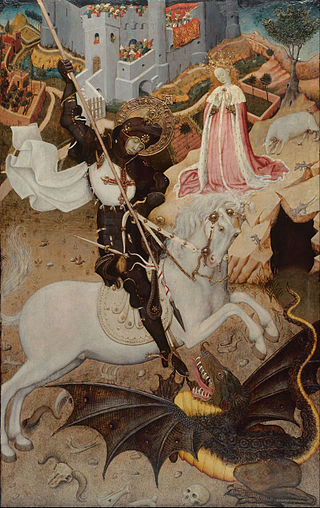
Terrassa is a city in central-eastern Catalonia (Spain). It is one of the two capitals of Vallès Occidental county, along with Sabadell.

Ciutat Vella is a district of Barcelona, numbered District 1. The name means "old city" in Catalan and refers to the oldest neighborhoods in the city of Barcelona, Catalonia, Spain. Ciutat Vella is nestled between the Mediterranean Sea and the neighborhood called l'Eixample.

Josep Puig i Cadafalch was a Spanish Modernista architect who designed many significant buildings in Barcelona, and a politician who had a significant role in the development of Catalan institutions. He was the architect of the Casa Martí, which became a place of ideas, projects and social gatherings for such well-known Catalans as Santiago Rusiñol and Ramon Casas.

Jaume Plensa i Suñé is a Spanish visual artist, sculptor, designer and engraver. He has also created opera sets, video projections and acoustic installations.

Lluís Domènech i Montaner was a Catalan architect who was very much involved in and influential for the Catalan Modernisme català, the Art Nouveau/Jugendstil movement. He was also a Catalan politician.

The Barcelona Museum of Contemporary Art is a contemporary art museum situated in the Plaça dels Àngels, in El Raval neighborhood, Ciutat Vella district, in Barcelona, Catalonia, Spain. The museum opened to the public on 28 November 1995.

Bernat Martorell was the leading painter of Barcelona, in modern-day Spain. He is considered to be the most important artist of the International Gothic style in Catalonia. Martorell painted retable panels and manuscript illuminations, and carved sculptures and also provided designs for embroideries.

Josep Maria Subirachs i Sitjar was a Spanish sculptor and painter of the late 20th century. His best known work is probably the Passion Facade of the basilica of the Sagrada Família in Barcelona. He was controversial, as he did not make any concessions to the style of the architect who designed the building, Antoni Gaudí.

Albert Ràfols-Casamada was a Spanish painter, poet and art teacher involved in the vanguard movements of his time. He is considered one of the most important, multifaceted Catalan artists of his time. His artwork began in the post-expressionist, figurative sphere but soon developed into his own abstract style grounded in a poetic rendering of everyday reality.

Antoni Gaudí i Cornet was a Catalan architect and designer from Spain, known as the greatest exponent of Catalan Modernism. Gaudí's works have a highly individualized, sui generis style. Most are located in Barcelona, including his main work, the church of the Sagrada Família.

Josep Pascó i Mensa (1855–1910), was a painter, illustrator and designer from Catalonia, an autonomous community of Spain, mostly noted for book illustrations and theater set design. He was born in Sant Feliu de Llobregat in 1855 and died in Barcelona in 1910. He trained as a painter at the Escola de la Llotja with Simó Gómez and at the workshop of designer Josep Planella. He began his career as a mural painter but then switched to canvas, mostly landscapes. One of his most original paintings is that of the flag of the Cau Ferrat in Sitges.
Salon Pedal is a color lithograph on paper designed in 1897 by the Catalan artist Alexandre de Riquer. The print's design evokes the decorative style seen in Modernisme art. The artwork is in the collection of Museu Nacional d'Art de Catalunya, in Barcelona.

The Apse of Sant Climent de Taüll is a Romanesque fresco in the National Art Museum of Catalonia, Barcelona. The fresco is one of the masterpieces of the European Romanesque, from which the unknown Master of Taüll takes his name. It was painted in the early 12th century in the church of Sant Climent de Taüll in the Vall de Boí, Alta Ribagorça in the Catalan Pyrenees. The mural covered the apse of the church. In 1919-1923 it was moved, along with other parts of the fresco decoration, to Barcelona, in an attempt to preserve the murals in a stable, secure museum setting.

Antoni Vila Casas was a Spanish pharmaceutical executive and philanthropist.

Jordi Puigneró i Ferrer is a Catalan IT engineer and politician. He served as Vice President of Spanish Autonomous Community of Catalonia and Minister of Digital Policies and Territory since May 2021 until 29 September 2022. He previously served between 2018 and 2021 as minister of Digital Policies and Public Administration of the Government of Catalonia. He is a member of Together for Catalonia (JUNTS) political party. He is considered the designer and architecture of the Catalan Digital Republic project.

Jordi Borràs i Abelló is a Catalan illustrator and photojournalist with an expertise in the far-right and neonazi movements from all over Europe.

Ramon Vives Ayné was a Catalan painter. He was especially known for still-lifes, portraits and hunting scenes. Most of his work was in a naturalistic style. Some sources give his year of death as 1904.

Eusebi Planas i Franquesa ) was a Catalan graphic artist, lithographer and watercolorist.

Roser Capdevila i Valls is a Spanish Catalan writer and illustrator, known internationally following the publication of the film adaptation of "Les tres bessones", The Triplets. The characters of "Les tres bessones" were inspired by Capdevila's three daughters, Teresa, Anna, and Helena.
Pilar Vélez Vicente, is an art historian and cultural manager. From 2012 until her retirement in 2022, she was the director of the Design Museum of Barcelona, the product of the integration of the collections of the Decorative Arts Museum, the Ceramics Museum, the Museum Textile and Clothing and the city's Graphic Arts Office. Pilar Vélez replaced Marta Montmany in the position, when she retired during the spring of 2012.




















